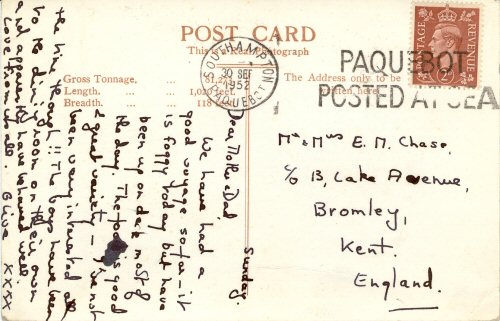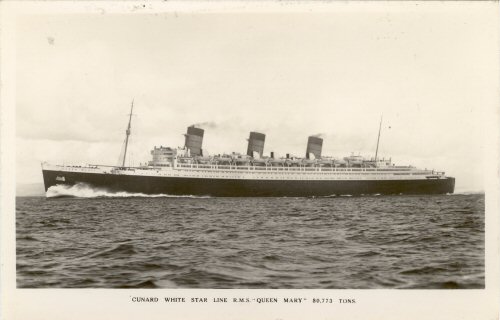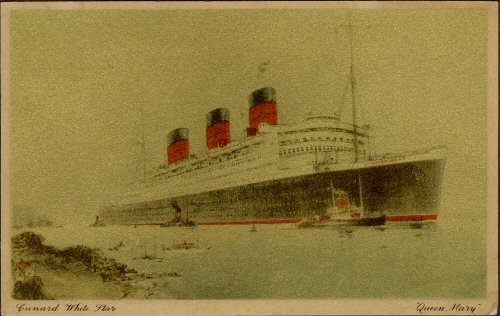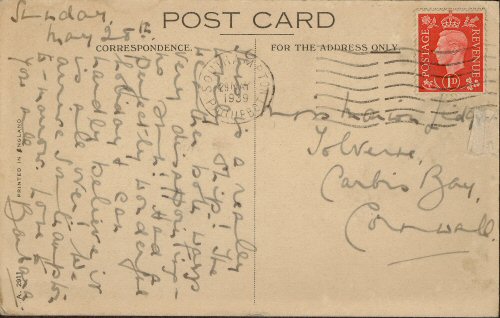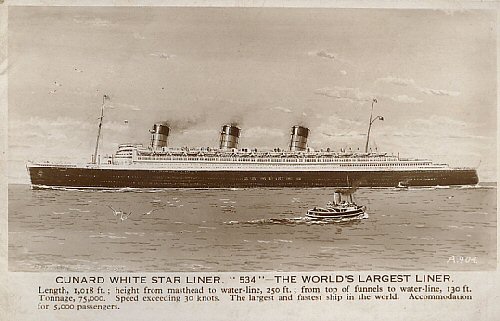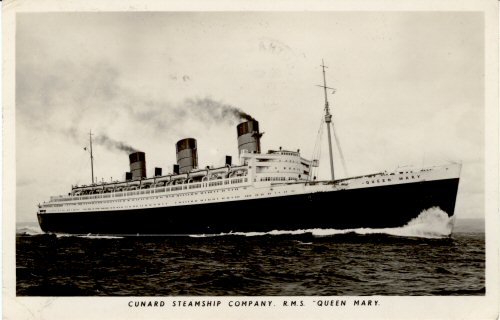
The construction of the Queen Mary represented the zenith of passenger ship building for Cunard. Plans began for a new record breaking liner to replace the Mauretania as early as 1926. It was not until 1930, however, that Cunard announced that a new 1000 ft, 81,000 ton liner was to be built by John Brown & Co Ltd. The keel of the ship was laid down on 31 January 1931. The building proceeded well and the launch was scheduled for May 1932. On 11 December 1931 the Cunard Board announced that work on the ship was to be suspended. The world economic depression had hit the shipbuilding industry and Cunard were forced to pay all outstanding bills and lay off the Clydeside workforce indefinitely.
It was during 1931 that Cunard had started negotiations to buy out its main rival, the White Star Line. Although these early attempts failed Cunard entered negotiations with the Government in 1933. In December 1933 an agreement was reached whereby the two companies would merge to form Cunard White Star Ltd and the Government would lend the company £9.5 million. The majority of this sum was to be used to complete the Queen Mary and build a sister ship. In April 1934 work began again on the ship. The work was completed by August and the ship was launched on 26 September by Queen Mary. Then it was taken to its fitting out berth.
The work on the ship was completed in March 1936 and it sailed out of the Clyde as far as Arran for preliminary trials. After sailing to Southampton to be painted, the Queen Mary was handed over to Cunard on 11 May. The passenger accommodation emphasised the first two classes, cabin and tourist. The propulsion machinery of the ship produced a massive 160,000 SHP and gave it a speed of over 30 knots. It made an inaugural cruise from Southampton on 14 May and then made its maiden voyage, on the Southampton-Cherbourg-New York route, on 27 May. Despite expectations that the ship would try to break speed records on its first voyage a thick fog destroyed any hope of this. The Queen Mary spent a short time in drydock during July whilst adjustments were made to the propellers and turbines. When the ship returned to service, in August, it made a record voyage from Bishop's Rock to Ambrose light and took the Blue Riband from the Normandie.
The ship went into drydock in December and alterations were made to the bulkheads. By May 1937 the Queen Mary had completed one year's service and had carried a total of 56,895 passengers. In August 1938 it regained the Blue Riband form the Normandie and set new records for both the eastbound and westbound crossings. It made its last commercial voyage from Southampton on 30 August 1939 and then remained berthed at New York until the end of the year whilst it was decided what role the ship would play in the war.
On 7 March 1940 the newly completed Queen Elizabeth arrived to join the Queen Mary, Mauretania and Normandie at New York. On 21 March the Queen Mary left New York under orders to sail for Cape Town and Sydney. On arrival work began converting the ship into a troopship. The luxury furnishings were removed and tiers of bunks and hammocks were fitted. Although small calibre guns were fitted on the ship its main protection was to be its speed. On 4 May the ship left for the Clyde with 5,000 troops of the Australian Imperial Force on board. It arrived there on 16 June and then sailed for Singapore carrying troops to bolster the defence in view of Japan's increasing threat. After an overhaul there it returned to Sydney and then made trooping voyages between there and India for the rest of the year.
The ship was drydocked again in February 1941 and then sailed between Australian ports and Singapore and Suez until November. As the Indian Ocean was becoming increasingly dangerous, with war looking imminent in the Far East and Pacific, the Queen Mary sailed to Boston. Here its trooping capacity was increased to 8,500 and it was fitted with heavier calibre guns and anti-aircraft cannons. The Queen Mary's future role was to be on the North Atlantic, however one urgent trip carrying US troops to Sydney was the priority. By late July 1942 it had returned to New York. In the following months it sailed to the Clyde and Suez and then returned to the USA with a complement of German POW's. On 2 August 1942 it began making fast eastbound voyages carrying between 10,000-15,000 US troops at a time. On one of these voyages the ship had the worst collision of its career.
When it was approaching the Clyde the Queen Mary required an anti-aircraft escort, amongst these was the cruiser HMS Curacoa. On 2 October the escort ships were sighted. The Queen Mary was steaming at 28 knots in zig-zag pattern whilst the Curacoa, whose best speed was 26 knots, kept as close as possible. The Queen Mary overtook its escort and then the zig-zag pattern of the two ships converged and it collided with the Curacoa close to its stern and sliced straight through the ship. Out of 430 crew members on the cruiser only 101 survived. Although there was damage beneath the waterline the Queen Mary was able to continue. With over 11,000 troops on board the Queen Mary could not stop to assist and it sailed straight to the Clyde. A long legal battle between the Admiralty and Cunard eventually laid the blame equally on both vessels.
From October to December 1942 it was being repaired at Boston and then returned to the Clyde. On 23 December it left for Cape Town, Suez and Sydney carrying British troops to the Middle East and Australian troops back home. It returned in April 1943 and then berthed in New York in May. After this it began a ferry service for US troops which was to be its role for the remainder of the war. The Queen Mary's role in this capacity is the one for which it is best remembered. The end of the war in Europe in May 1945 meant that there was an urgent need to redeploy thousands of US combat troops to the conflict in the Pacific and Far East. The Queen Mary sailed to New York to be refitted and then began the long process of repatriation. In January 1946 it began transporting GI brides to their new homes. By 3 May it transferred to Halifax to repatriate the wives and children of Canadian servicemen, which continued until September.
On 27 September the Queen Mary was handed back to Cunard. During its war service it had travelled over 600,000 miles and carried nearly 800,000 people. A ten month refit was then embarked upon at Southampton. Besides being refurnished for the commercial service a new stem and air-conditioning were fitted. The passenger accommodation was also altered to house 711 1st class, 707 cabin class and 577 tourist class passengers. It made its first sailing after this on 31 July 1947, from Southampton to New York. Before the end of 1947, however, industrial troubles started to affect the service. Air travel was becoming increasingly popular and once the ship had ran aground at Cherbourg on 1 January 1949 many of the passengers chose to fly to the USA instead. Although the ship was still capable of making fast crossings it was unable to compete with the new American liner United States, and in July 1952 the American ship took the Blue Riband with an average speed of 35.59 knots.
In March 1958 the ship was fitted with stabilisers by Denny-Brown. By the beginning of the next decade there was already speculation about the ship's future. In December 1963 it made its first cruise, to the Canaries. By 1965 this had become a larger part of the ship's role. A seamen's strike in May 1966 cost Cunard £4 million and spelt the end for the Queen Mary. In 1967 Cobh was added to the ship's Southampton-New York route but by now it was losing thousands of pounds a day. It made its last transatlantic crossing on 16 September 1967. There was considerable speculation regarding what the future use of the ship would be but this ended in July when Cunard agreed to sell the liner to the town of Long Beach for £1,230,000.
The Queen Mary's journey to Long Beach was was turned into a cruise to recoup some of the costs of the voyage. It left on 31 October and called at Lisbon, Las Palmas, Rio de Janiero, Valparaiso, Callao, Balboa, Acapulco and finally at Long Beach. It arrived at Long Beach on 9 December to begin its new role as a museum, hotel and conference centre. The Queen Mary still remains there today as a testament to the supreme achievement of the Atlantic ferry.
